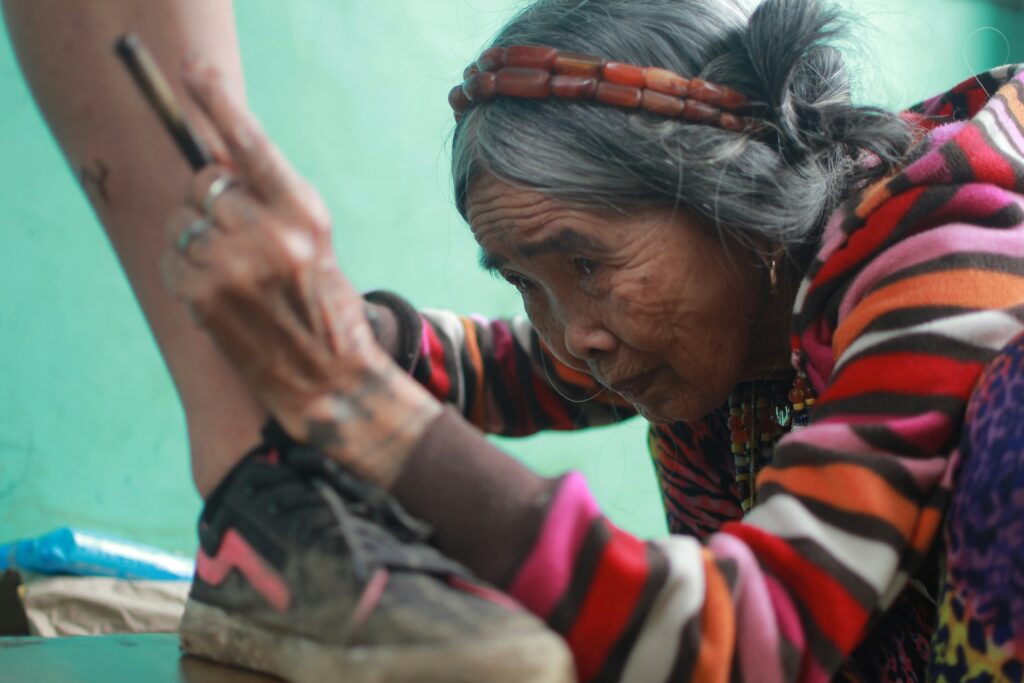
Ati Atihan One Of Best Festival In The Philippines
Posted in Culture, Destinations, Festivals and Events, Hotels, Visayas
Introduction to the Ati Atihan Festival

The Ati Atihan Festival, a vibrant and culturally rich celebration, stands as a testament to the Philippines‘ diverse heritage. Originating in Kalibo, Aklan, this annual festival is celebrated in honor of the Santo Niño, or the Holy Child Jesus. The event, which takes place every January, is one of the country’s most awaited and highly esteemed festivities, drawing visitors from across the globe who are eager to witness and partake in its unique traditions.
Ati Atihan, which means “to be like Atis” or “make-believe Atis,” pays homage to the indigenous Ati people. The festival’s roots can be traced back to the 13th century when Malay settlers arrived in the region and were welcomed by the Atis. Over time, the celebration has evolved to incorporate elements of Catholicism, particularly the veneration of the Santo Niño, reflecting the Philippines‘ historical and cultural synthesis.
The festival is renowned for its lively and colorful atmosphere. Participants don elaborate costumes adorned with feathers, paint their faces in black, and engage in traditional dances and music, creating a vibrant spectacle that weaves together the threads of history, religion, and community. Street dancing, drumbeats, and chants fill the air, as revelers march through the streets in a joyous display of unity and devotion.
Ati Atihan’s significance extends beyond mere celebration; it is a cultural cornerstone that fosters a sense of identity and continuity for the people of Aklan and the wider Filipino community. The festival not only honors the past but also serves as a living tradition that continues to inspire and bring people together. Its dynamic and inclusive nature ensures that Ati Atihan remains a cherished event, embodying the enduring spirit and resilience of the Filipino people.
Historical Background and Origins
The Ati Atihan Festival, one of the Philippines‘ most vibrant and enduring cultural celebrations, has a rich history that dates back to pre-colonial times. The festival’s roots can be traced to the Ati tribe, the original inhabitants of the island of Panay. According to legend, the Ati tribe generously welcomed Malay settlers who arrived from Borneo fleeing political strife. In gratitude, the Malays offered gifts to the Ati and held a feast, marking the first Ati Atihan celebration. The phrase “Ati Atihan” translates to “to be like Atis,” indicating the effort of the Malays to honor and imitate the Ati people.
As time progressed, the Ati Atihan Festival evolved significantly. During the Spanish colonial period, the festival began to incorporate Christian elements, blending indigenous traditions with Catholic rituals. This transition was notably marked by the introduction of the Santo Niño, or the Holy Child Jesus, into the festivities. The Spaniards saw the festival as an opportunity to propagate Christianity, and the Ati Atihan became a celebration not only of indigenous heritage but also of Christian faith. The image of the Santo Niño was paraded through the streets, and the festival’s activities were imbued with religious significance.
Despite these changes, the core spirit of the Ati Atihan Festival remained intact. The festival continued to be a vibrant display of dance, music, and colorful costumes, with participants painting their faces with soot and donning elaborate tribal attire. This practice pays homage to the original Ati tribe and symbolizes unity and gratitude. Over the centuries, the festival has grown in scale, drawing visitors from all over the world who come to experience its unique blend of cultural and religious traditions.
Today, the Ati Atihan Festival stands as a testament to the Philippines‘ rich cultural tapestry, showcasing the enduring legacy of the Ati tribe and the transformative impact of historical events on local traditions. The festival’s ability to adapt and thrive through various cultural shifts underscores its significance as a cultural cornerstone in the Philippines.
Significant Rituals and Traditions
The Ati Atihan Festival, a vibrant and dynamic celebration in the Philippines, is steeped in significant rituals and traditions that showcase the rich cultural heritage of the Aklan province. One of the most iconic aspects of this festival is the ‘sadsad,’ or street dancing, where participants, both locals and tourists, take to the streets in a spirited display of unity and joy. Dressed in elaborate costumes, they move rhythmically to the infectious drumbeats that pervade the air, creating an atmosphere of exuberance and camaraderie.
A key tradition within the Ati Atihan Festival is the ‘panaad,’ or vow dance. This ritual is a poignant expression of gratitude and devotion, where devotees fulfill promises made in exchange for blessings received. The ‘panaad’ is a deeply personal and spiritual act, often performed by individuals who have experienced significant life events or miracles. It underscores the festival’s roots in faith and the community’s deep connection to their spiritual beliefs.
Traditional costumes and body paint are central to the festival’s visual spectacle. Participants don attire inspired by the indigenous Ati people, featuring vibrant colors, intricate patterns, and natural materials. The use of body paint, often in bold black and white designs, is a homage to the traditional appearance of the Ati people and serves as a symbol of cultural pride and identity. These visual elements not only enhance the festival’s aesthetic appeal but also serve as a living homage to the region’s ancestral heritage.
Music, particularly the rhythmic drumbeats, plays a pivotal role in the Ati Atihan Festival. The constant, lively percussion creates an energetic backdrop that drives the festivities forward. It is the heartbeat of the celebration, uniting participants in a shared rhythm and amplifying the collective joy. The drumbeats, along with other traditional instruments, infuse the festival with an infectious energy that is both captivating and invigorating.
Together, these rituals and traditions form the essence of the Ati Atihan Festival, making it a unique and deeply meaningful celebration that honors the spirit and heritage of the Philippines.
The Role of Religion in Ati Atihan
The Ati Atihan Festival is deeply rooted in religious observance, with the veneration of the Santo Niño (Holy Child) being central to its celebrations. This festival, held annually in January in Kalibo, Aklan, honors the Santo Niño, blending indigenous beliefs with Roman Catholic practices. The religious dimension of the Ati Atihan makes it not only a cultural event but also a significant spiritual occasion for the participants and the local community.
The religious activities during Ati Atihan begin with the novena, a nine-day series of prayers dedicated to the Holy Child. This period of devotion culminates in a grand procession, where devotees carry images of the Santo Niño through the streets of Kalibo. The faithful, dressed in vibrant and elaborate costumes, chant “Viva Señor Santo Niño” as they parade, reflecting the deep-seated religious fervor that underpins the festival.
A key feature of the Ati Atihan is the religious mass celebrated in honor of the Santo Niño. This mass is a focal point of the festival, drawing thousands of worshippers from across the Philippines and beyond. The mass is an expression of gratitude and reverence, highlighting the spiritual significance of the Santo Niño to the people of Kalibo. The blending of indigenous and Catholic rituals during the mass exemplifies the unique cultural and religious synthesis that defines Ati Atihan.
Throughout the festival, numerous other religious activities take place, such as the “Paeapak,” where devotees seek blessings by touching the image of the Santo Niño. This act of devotion reflects the deep connection between the festival’s participants and their faith. The incorporation of indigenous practices, like the rhythmic beating of drums and the wearing of traditional attire, enriches the festival’s religious tapestry, making it a distinctive and multifaceted celebration.
In essence, the religious aspects of the Ati Atihan Festival illustrate a profound blend of faith and culture. By honoring the Santo Niño through processions, masses, and other devotional acts, the festival reinforces the spiritual identity of its participants while celebrating the rich cultural heritage of the Philippines.
Cultural Impact and Significance
The Ati Atihan Festival holds a profound cultural impact on both the local community of Kalibo and the Philippines at large. As one of the oldest and most vibrant festivals in the country, it plays a crucial role in preserving and promoting Filipino heritage. This annual celebration is more than just a festivity; it is a testament to the rich history and traditions that define the Filipino identity. The Ati Atihan Festival, with its roots tracing back to pre-colonial times, serves as a living narrative of the nation’s past, showcasing a blend of indigenous and Catholic traditions.
One of the most significant cultural contributions of the Ati Atihan Festival is its ability to foster community spirit. The festival brings together people from various walks of life to celebrate unity and shared heritage. Participants don traditional costumes, paint their faces black, and dance to the rhythmic beats of drums, embodying the spirit of the Aetas, the festival’s namesake. This immersive experience not only strengthens communal bonds but also instills a sense of pride and belonging among the locals. The festival’s inclusive nature encourages participation from both residents and visitors, promoting a culture of mutual respect and camaraderie.
Furthermore, the Ati Atihan Festival significantly boosts tourism, attracting thousands of tourists from across the globe. This influx of visitors provides an economic boon to the local economy, supporting businesses and creating job opportunities. The international attention garnered by the festival also helps in putting the Philippines on the global cultural map, showcasing the country’s unique traditions and vibrant celebrations.
Reflecting the resilience and creativity of the Filipino people, the Ati Atihan Festival is a symbol of adaptability and innovation. Despite various challenges, including natural disasters and socio-economic hurdles, the festival continues to thrive, adapting to contemporary times while preserving its core essence. This enduring spirit mirrors the broader Filipino resilience, a quality admired and celebrated worldwide.
The Ati Atihan Festival, a vibrant and joyous celebration held in Kalibo, Aklan, is a testament to the rich cultural heritage of the Philippines. As the festival approaches, the entire community, along with enthusiastic tourists, becomes immersed in a flurry of preparations. The crafting of intricate costumes is a significant aspect of the festival, with locals dedicating countless hours to creating elaborate and colorful attire. These costumes, often adorned with feathers, beads, and indigenous patterns, are a nod to the indigenous Ati people, from whom the festival derives its name.
In the weeks leading up to the Ati Atihan, the streets of Kalibo are alive with the sounds of rehearsals. Dance troupes can be seen practicing their routines, perfecting their synchronized movements to the rhythmic beat of drums. These rehearsals are not just about perfecting performances but also about fostering community spirit and camaraderie. Both locals and visitors eagerly participate, creating an atmosphere of unity and shared excitement.
The anticipation for the festival builds as the days pass, with the energy in Kalibo becoming almost palpable. This excitement is not confined to a select group; rather, the Ati Atihan Festival is known for its inclusivity. Everyone, regardless of age, background, or nationality, is encouraged to join the revelry. Tourists from around the world find themselves welcomed with open arms, invited to don traditional costumes and partake in the festivities. This sense of inclusiveness is a defining feature of the Ati Atihan, making it a truly communal celebration.
As the festival draws near, the spirit of Ati Atihan permeates every corner of Kalibo. From costume-making workshops to dance rehearsals, the preparation phase is a vibrant prelude to the main event. The collective effort of the community, coupled with the enthusiastic participation of visitors, ensures that the Ati Atihan Festival is not just a spectacle to behold but an experience to cherish.
Ati Atihan Festival Today
The Ati Atihan Festival today stands as a vibrant testament to the enduring spirit of Filipino culture. Over the years, the festival has experienced various transformations, adapting to the demands of modern times while striving to retain its rich traditional essence. One of the most notable changes is the integration of contemporary elements into the celebrations, such as elaborate musical performances, modern dance routines, and the use of advanced technology in parade floats and stage setups. These additions have not only enhanced the visual and auditory appeal of the festival but also attracted a broader audience, including international tourists.
However, the evolution of the Ati Atihan Festival has not been without challenges. One significant issue is the creeping commercialization that threatens to overshadow the festival’s cultural and historical significance. The influx of corporate sponsorships and the proliferation of merchandise have, at times, shifted the focus from the festival’s roots to profit-driven motives. This commercialization has sparked a debate among purists and modernists about the best way to honor the festival’s heritage while embracing necessary progress.
Maintaining traditional practices amidst these changes is another challenge the festival faces. Efforts to preserve the authentic rituals and customs of the Ati Atihan Festival are ongoing, with community leaders and cultural advocates working tirelessly to ensure that the essence of the festival remains intact. Initiatives such as educational programs and workshops aim to educate the younger generation about the festival’s history and significance, fostering a deeper appreciation and understanding of their cultural heritage.
Recent celebrations of the Ati Atihan Festival have exemplified this delicate balance between tradition and modernity. The festival has adapted to contemporary times by incorporating social media and digital platforms to engage with a wider audience. Live streaming of events, interactive apps, and online campaigns have made the festival more accessible, allowing people from all over the world to partake in the festivities virtually. Despite these modern adaptations, the core spirit of the Ati Atihan Festival—celebrating the unity and resilience of the Filipino people—remains steadfast, resonating with every drumbeat and dance step.
Tips for Attending the Ati Atihan Festival
Planning to attend the Ati Atihan Festival can be an exhilarating experience, but it requires thoughtful preparation to ensure a smooth and enjoyable visit. First and foremost, make your travel arrangements well in advance. Kalibo, the capital of Aklan province, hosts the festival, and its nearest airport is Kalibo International Airport. Flights can fill up quickly during the festival period, so booking early is crucial. Additionally, consider alternative routes such as flying into nearby airports like Caticlan and then taking a bus or van to Kalibo.
Accommodation in Kalibo also needs early planning. The festival attracts a significant number of visitors, and hotels and guesthouses tend to be fully booked months in advance. Look for places that are within walking distance of the main festivities to avoid transportation hassles. If you’re on a budget, homestays can be a more economical option and offer a more immersive cultural experience.
The Ati Atihan Festival is known for its vibrant and colorful celebrations, so dress accordingly. Lightweight, breathable clothing is recommended as the weather can be hot and humid. Comfortable shoes are a must, given the amount of walking and dancing involved. Don’t forget to bring sun protection, including hats and sunscreen, to shield yourself from the intense tropical sun.
To fully immerse yourself in the Ati Atihan Festival, participate in the street dancing and parades. The festival’s highlight is the “sadsad,” a communal dance where participants paint their faces and bodies, don traditional costumes, and join in the rhythmic dance processions. Respect cultural and religious aspects by observing local customs and participating in church services if you choose to. The festival is deeply rooted in both indigenous and Catholic traditions, so showing reverence, especially during the religious processions and masses, is appreciated.
Must-see events include the opening salvo, the grand parade, and the Pilgrims’ Mass. Each offers a unique glimpse into the rich cultural tapestry of the Ati Atihan Festival. Finally, always stay hydrated and be mindful of your belongings as large crowds can make it easy to misplace items.

Go Explore Philippines
Welcome to GoExplorePhilippines.com, your go-to guide for exploring the Philippines. Discover tips, travel guides, and stories about the stunning landscapes, vibrant culture, and delicious cuisine of Luzon, Visayas, Mindanao, and beyond. Join us on an adventure to uncover the hidden gems of the Philippines!











